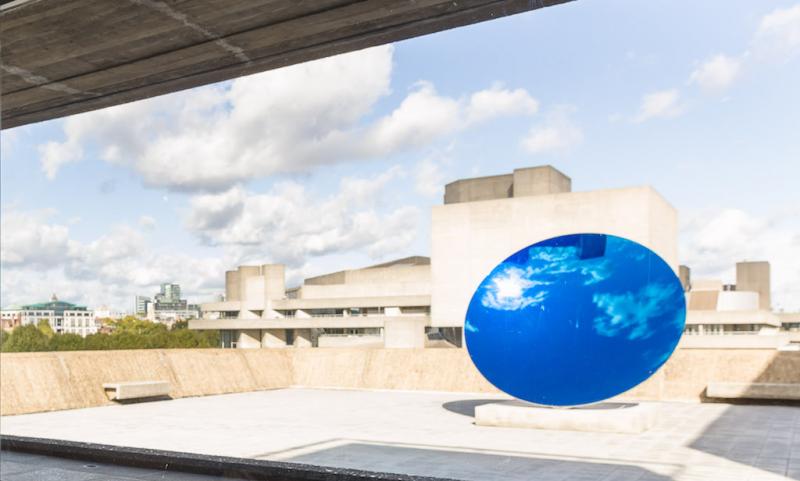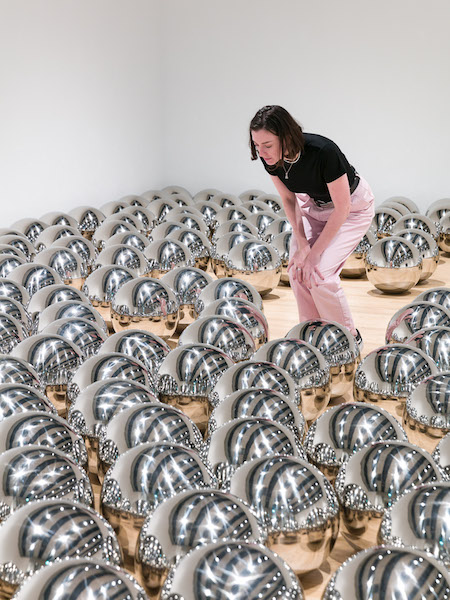Space Shifters, Hayward Gallery review - seeing is not always believing | reviews, news & interviews
Space Shifters, Hayward Gallery review - seeing is not always believing
Space Shifters, Hayward Gallery review - seeing is not always believing
Sculptures that trick the eye and gladden the heart

There are some wonderful things in Space Shifters, the Hayward Gallery’s autumn exhibition. The selection of work plays with one’s perceptions of space and everything in it.
Richard Wilson’s 20:50 was on display in London almost continuously from 1991, when it was installed at Charles Saatchi’s Gallery in St John’s Wood, until 2015 when it was finally dismantled in his Chelsea gallery. That’s 24 years; surely we’ve seen enough of it, then? Not a bit of it. The lake of black oil mirrors its environment to magical effect, but in Chelsea visitors were not allowed to enter the walkway that takes you to the heart of the installation and were deprived of the full dizzying experience.
 Here you can venture out into what feels like infinite space (Pictured above). Those who suffer from vertigo be warned; you look down into a perfect reflection of the skylights overhead and feel as alone as if you were standing on an Olympic diving board metres up in the air. These are some of the most exhilarating moments you are likely to spend in the presence of contemporary art, so grit your teeth and queue.
Here you can venture out into what feels like infinite space (Pictured above). Those who suffer from vertigo be warned; you look down into a perfect reflection of the skylights overhead and feel as alone as if you were standing on an Olympic diving board metres up in the air. These are some of the most exhilarating moments you are likely to spend in the presence of contemporary art, so grit your teeth and queue.
Other pieces have lasted less well. Its hard to remember why the work of American minimalists like Robert Irwin, John McCracken and Fred Eversley once seemed so refreshing. Larry Bell’s large scale installation, Standing Walls has also been recreated. Walking between the elegant grey and clear glass panels is still a poetic experience, but since it was first shown in 1969, so many artists have built installations inspired by it that the idea now feels decidedly jaded.
 To avoid that sense of déja vu you have to be as good as Polish artist, Alicja Kwade. Finding your way around her installation WeltenLinie (pictured below) makes you feel like a child negotiating its first steps. Rocks and tree trunks are arranged in interconnecting rooms as elegantly as if this were a zen garden. Black frames delineate the spaces, but while some are empty and allow you to step through them, others are filled with mirrors. The objects are often doubled, but while some of these twins are reflections, others are facsimiles. And to confuse one’s sense of reality even further, some of the rocks are stone and the tree trunks wood, but others are made from bronze, aluminium, rusted iron or fossilised wood. Reality is played off against its virtual and artificial counterparts In a sophisticated game that is pure pleasure to encounter.
To avoid that sense of déja vu you have to be as good as Polish artist, Alicja Kwade. Finding your way around her installation WeltenLinie (pictured below) makes you feel like a child negotiating its first steps. Rocks and tree trunks are arranged in interconnecting rooms as elegantly as if this were a zen garden. Black frames delineate the spaces, but while some are empty and allow you to step through them, others are filled with mirrors. The objects are often doubled, but while some of these twins are reflections, others are facsimiles. And to confuse one’s sense of reality even further, some of the rocks are stone and the tree trunks wood, but others are made from bronze, aluminium, rusted iron or fossilised wood. Reality is played off against its virtual and artificial counterparts In a sophisticated game that is pure pleasure to encounter.
Yayoi Kusama’s Narcissus Garden, 1966 (Pictured above right) could have been equally inspiring had it been properly installed. Arranged in a walk-through space divided by a pathway, her glistening steel balls become little more than decorative asides. To achieve the full, mesmerising effect described by the artist as “infinity, self-obliteration and compulsive repetition”, they need to fill the space completely and thereby rob one of any sense of scale or dimension. De Wain Valentine’s Gray Column has also been compromised. A slender wedge of dark grey resin that rises out of the floor, it is surrounded by rope barriers that produce banal reflections and kill the mystery of its misty surface.
Nothing could destroy the beauty of Ann Veronica Janssens’ Magic Mirrors. Two sheets of shattered safety glass rest against the wall, sandwiched between clear glass and a polythene film that filters out certain colours. Most pleasing is the discrepancy between their physical simplicity and their visual complexity. The surfaces glow with an opalescent shimmer that, in reflecting the rest of the room, constantly shifts between green and magenta or bronze and turquoise and casts yellow and purple shadows on the wall behind. Meanwhile, looping across the nearby wall is a red plastic bannister by Polish artist Monika Sosnowska. Having crept up the stairs by entwining itself round the brass handrail, it explodes into the upper gallery to resemble a scalextric track seriously scrambled in an earthquake.
 I’ve never much liked Anish Kapoor’s mirror sculptures; they distort the space around them in much the same way as fairground mirrors and, to me, this has always seemed like a cheap trick; but at the Hayward I had a conversion. Installed on the terrace overlooking Waterloo Bridge, Sky Mirror, 2016 (main picture) transforms the view. Against the dull monochrome of the concrete National Theatre and the rigid geometry of the glass and steel office blocks behind, the bright blue bowl appears like a glowing alien being. Its vivid colour makes even a blue sky look unhealthily pale. Reversing everything it reflects, the convex disc brings the sky down to earth and elevates the gallery roof so the skylights are silhoutted like a row of jagged teeth above the orb of the sun. And such is its intensity that the sculpture casts a blue light onto the interior walls of the gallery, bringing the outside in, as it were. Marvellous!
I’ve never much liked Anish Kapoor’s mirror sculptures; they distort the space around them in much the same way as fairground mirrors and, to me, this has always seemed like a cheap trick; but at the Hayward I had a conversion. Installed on the terrace overlooking Waterloo Bridge, Sky Mirror, 2016 (main picture) transforms the view. Against the dull monochrome of the concrete National Theatre and the rigid geometry of the glass and steel office blocks behind, the bright blue bowl appears like a glowing alien being. Its vivid colour makes even a blue sky look unhealthily pale. Reversing everything it reflects, the convex disc brings the sky down to earth and elevates the gallery roof so the skylights are silhoutted like a row of jagged teeth above the orb of the sun. And such is its intensity that the sculpture casts a blue light onto the interior walls of the gallery, bringing the outside in, as it were. Marvellous!
- Space Shifters at the Hayward Gallery until 6 January 2019
- Read more visual arts reviews on theartsdesk
rating
Explore topics
Share this article
The future of Arts Journalism
You can stop theartsdesk.com closing!
We urgently need financing to survive. Our fundraising drive has thus far raised £49,000 but we need to reach £100,000 or we will be forced to close. Please contribute here: https://gofund.me/c3f6033d
And if you can forward this information to anyone who might assist, we’d be grateful.

Subscribe to theartsdesk.com
Thank you for continuing to read our work on theartsdesk.com. For unlimited access to every article in its entirety, including our archive of more than 15,000 pieces, we're asking for £5 per month or £40 per year. We feel it's a very good deal, and hope you do too.
To take a subscription now simply click here.
And if you're looking for that extra gift for a friend or family member, why not treat them to a theartsdesk.com gift subscription?
more Visual arts
 'We are bowled over!' Thank you for your messages of love and support
Much-appreciated words of commendation from readers and the cultural community
'We are bowled over!' Thank you for your messages of love and support
Much-appreciated words of commendation from readers and the cultural community
![SEX MONEY RACE RELIGION [2016] by Gilbert and George. Installation shot of Gilbert & George 21ST CENTURY PICTURES Hayward Gallery](https://theartsdesk.com/sites/default/files/styles/thumbnail/public/mastimages/Gilbert%20%26%20George_%2021ST%20CENTURY%20PICTURES.%20SEX%20MONEY%20RACE%20RELIGION%20%5B2016%5D.%20Photo_%20Mark%20Blower.%20Courtesy%20of%20the%20Gilbert%20%26%20George%20and%20the%20Hayward%20Gallery._0.jpg?itok=7tVsLyR-) Gilbert & George, 21st Century Pictures, Hayward Gallery review - brash, bright and not so beautiful
The couple's coloured photomontages shout louder than ever, causing sensory overload
Gilbert & George, 21st Century Pictures, Hayward Gallery review - brash, bright and not so beautiful
The couple's coloured photomontages shout louder than ever, causing sensory overload
 Lee Miller, Tate Britain review - an extraordinary career that remains an enigma
Fashion photographer, artist or war reporter; will the real Lee Miller please step forward?
Lee Miller, Tate Britain review - an extraordinary career that remains an enigma
Fashion photographer, artist or war reporter; will the real Lee Miller please step forward?
 Kerry James Marshall: The Histories, Royal Academy review - a triumphant celebration of blackness
Room after room of glorious paintings
Kerry James Marshall: The Histories, Royal Academy review - a triumphant celebration of blackness
Room after room of glorious paintings
 Folkestone Triennial 2025 - landscape, seascape, art lovers' escape
Locally rooted festival brings home many but not all global concerns
Folkestone Triennial 2025 - landscape, seascape, art lovers' escape
Locally rooted festival brings home many but not all global concerns
 Sir Brian Clarke (1953-2025) - a personal tribute
Remembering an artist with a gift for the transcendent
Sir Brian Clarke (1953-2025) - a personal tribute
Remembering an artist with a gift for the transcendent
 Emily Kam Kngwarray, Tate Modern review - glimpses of another world
Pictures that are an affirmation of belonging
Emily Kam Kngwarray, Tate Modern review - glimpses of another world
Pictures that are an affirmation of belonging
 Kiefer / Van Gogh, Royal Academy review - a pairing of opposites
Small scale intensity meets large scale melodrama
Kiefer / Van Gogh, Royal Academy review - a pairing of opposites
Small scale intensity meets large scale melodrama
 Jenny Saville: The Anatomy of Painting, National Portrait Gallery review - a protégé losing her way
A brilliant painter in search of a worthwhile subject
Jenny Saville: The Anatomy of Painting, National Portrait Gallery review - a protégé losing her way
A brilliant painter in search of a worthwhile subject
 Abstract Erotic, Courtauld Gallery review - sculpture that is sensuous, funny and subversive
Testing the boundaries of good taste, and winning
Abstract Erotic, Courtauld Gallery review - sculpture that is sensuous, funny and subversive
Testing the boundaries of good taste, and winning
 Edward Burra, Tate Britain review - watercolour made mainstream
Social satire with a nasty bite
Edward Burra, Tate Britain review - watercolour made mainstream
Social satire with a nasty bite
 Ithell Colquhoun, Tate Britain review - revelations of a weird and wonderful world
Emanations from the unconscious
Ithell Colquhoun, Tate Britain review - revelations of a weird and wonderful world
Emanations from the unconscious
